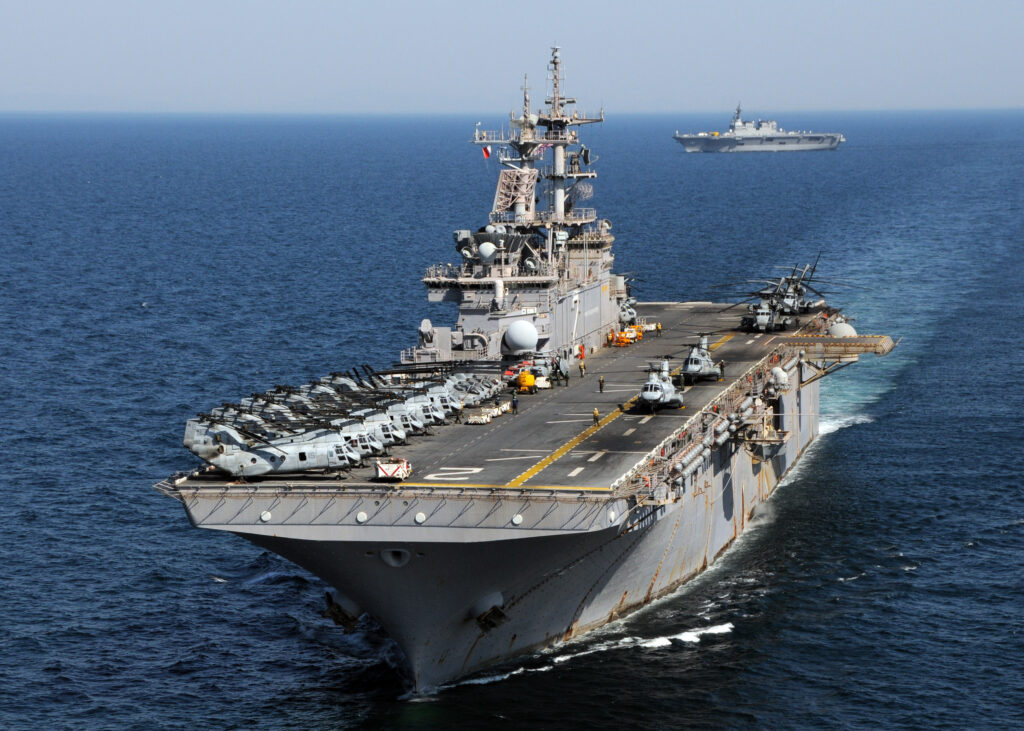Navy Warship Is Taking 3D Printer To Sea; Don’t Expect A Revolution
Posted on

The USS Essex (pictured) is the first Navy warship with a 3D printer.
WASHINGTON: The U.S. Navy has put a 3D printer on a warship for the first time. That’s a small revolution but don’t expect world-changing results any time soon.
Just ask Lt. Benjamin Kohlmann, a fighter pilot and member of the Chief of Naval Operation’s Rapid Innovation Cell (CRIC), a handpicked handful of junior officers and enlisted personnel who made getting 3D printers into the hands of sailors their first project. An earlier effort put a printer on an unarmed Joint High Speed Vessel (JHSV) for a few days, Kohlmann said, but now the USS Essex, a full-up amphibious assault ship, has a printer permanently installed. The crew has been making everything from disposable medical supplies (think plastic syringes), to a new cap they designed for an oil tank, to model planes to move around their mock-up of the flight deck, but they aren’t printing out spare parts for real airplanes any time soon.
“The low-hanging fruit [is] the small trinkets,” Kohlmann told me yesterday, from brackets and clasps to mock-ups for prototyping. But to make a mechanical component for a ship or an aircraft, “additive manufacturing has to get to the point where a part printed on the machine has the same strength and overall properties that a cast part has,” he said. “In some cases that is the case today. In others, in many more cases, it’s not…. Tensile and strength ratings don’t meet what’s required for high-stress environments.”
In fact, it’s an open question how well the Essex’s printer will even work once the ship gets underway. So far, Essex hasn’t left the dock with the printer aboard because the ship’s still finishing an 18-month maintenance overhaul. Part of the experiment will be to put instrumentation on the printer to see how it copes with engine vibration and the rolling seas.
It’s very much a crawl-walk-run approach, Kohlman told me, and “we are currently in ‘crawl.’”
3D printers ashore have gotten to “walk,” Kohlmann went on. Military labs and the defense industry have used additive manufacturing for years, principally to create quick prototypes but, increasingly, to build actual components. General Electric says it is making a high-complexity, high-temperature jet engine valve using 3D printing. Lockheed Martin and additive manufacturer Sciaky recently showed off a spar for the F-35 fighter – not yet certified for actual use – which 3D printing consultant Vivek Saxena estimates to be about 10 feet long.
So, 3D printing is “not just small parts,” Saxena told the DC chapter of the Royal Aeronautical Society last week. But it is still small business, he emphasized during his talk at the British Embassy. Additive manufacturing grew to an estimated $2 billion worldwide last year, he said. That’s not much of the $10.5 trillion figure for all manufacturing worldwide. In the aerospace business, 3D printing comprises just $250 million of a $160 billion total: a whopping 0.16 percent. In the most optimistic scenarios, said Saxena, a vice-president at ICF SH&E, additive manufacturing in aerospace will grow eight-fold by 2023, to about $2 billion – but since aerospace as a whole will grow too, that’s still less than 1 percent.
That said, Saxena went on, the defense sector might lead the way in several areas. There’s unmanned aircraft, for example, where safety requirements are less strict because there’re no people aboard. (Safety certification is the biggest hurdle for 3D printing, not the technology, he told the group). Additive manufacturing can also make small lots of parts for older weapons systems whose components aren’t in production anymore, like the Royal Air Force’s Tornado, for which the RAF is now using a 3D printer to make non-safety-of-flight items.
“I do a lot of prototype parts in additive [manufacturing],” said Pratt & Whitney vice-president Alan Epstein, speaking alongside Saxena at the British Embassy. “It’s sort of a dream technology for DARPA. It came out of DARPA,” in fact, since the Defense Advanced Research Projects Agency invested heavily in additive manufacturing in the 1980s.
But, I asked them, what about the military logistician’s dream of putting a 3D printer on every ship and at every forward base so troops can print out spare parts as needed instead of relying on long lines of supply?
“Come back in 20 years,” Epstein replied.
“I’ll give you an analogy,” he continued. Consider bread, one of humanity’s oldest manufactured products. After about 12,000 years, he said, we’ve simplified and systematized the process to the point that you can go buy a bread-making machine: “You can put the components in, and press the button, and bread comes out. It’s not very good bread — but it’s bread.”
What the military logistics community wants is the additive manufacturing equivalent of the bread-maker, something troops can toss materials into, press a button, and produce the needed part. Epstein doesn’t expect to see that happen for decades.
Lt. Kohlmann was similarly cautious. 3D printing may take off like the Internet in the 1990s, he told me in our interview, or it may plateau. But the potential benefits are big enough that it’s worth getting the new generation of Navy sailors familiar with the technology.
“Now who knows what kind of widget they would create, but I think it’s the cultural piece that’s going to be the [big] driver for now,” he told me. What matters most is letting people “play with the technology” so they can get comfortable with it, get proficient with it, and get ready to make the most of it when and if it does take off. That, Lt. Kohlmann said, “will put us in a far better position to adapt to those rapidly evolving realities.”
Subscribe to our newsletter
Promotions, new products and sales. Directly to your inbox.
